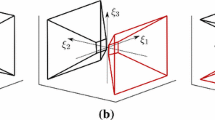Abstract
Multiresolution matching techniques for motion-induced change lead naturally to a hierarchical refinement of three-dimensional properties such as edge location, surface shape, spatial layout, and motion parameters. A hierarchical representation of these relationships is useful for subsequent analysis of more symbolic properties. Aggregate information about larger surfaces is available at the coarser levels of the hierarchy. This can be used to normalize values at finer levels so that detailed, local properties are not hidden by grosser effects.
Access this chapter
Tax calculation will be finalised at checkout
Purchases are for personal use only
Preview
Unable to display preview. Download preview PDF.
Similar content being viewed by others
References
D. A. Marr: Vision; A Computational Investigation into the Human Representation and Processing of Visual Information (Freeman, San Francisco, CA, 1982)
W. F. Clocksin: Perception of surface slant and edge labels from optical flow: a computational approach, Perception 9 253–269 (1980)
S. Ullman: The Interpretation of Visual Motion (MIT Press, Cambridge, MA, 1979)
Ho H. Nagel: Representation of moving rigid objects based on visual observations. Computer 14(8), 29–39 (1981)
K. Prazdny: Egomotion and relative depth map from optical flow, Biological Cybernetics 36, 87–102 (1980)
H. C. Longuet-Higgins, K. Prazdny: The interpretation of a moving retinal image, Proc. Royal Society (London) B208, 385–397 (1980)
D. D. Hoffman: “Inferring Shape from Motion Fields”, Artificial Intelligence Laboratory Memo 592, MIT (1980)
D. T. Lawton: “Constraint-based inference from image motion”, in Proc. Nat’l, Conf. on Artificial Intelligence, Stanford, CA, 1980, pp. 31–34
K. Prazdny: “Relative Depth and Local Surface Orientation from Image Motion”, Computer Science Technical Report TR-996, University of Maryland (1981)
A. R. Bruss, B. K. P. Horn: “Passive Navigation”, Artificial Intelligence Laboratory Memo 645, MIT (1981)
K. Prazdny: Determining the instantaneous direction of motion from optical flow generated by a curvilinearly moving observer. Computer Graphics Image Processing 17, 238–248 (1981)
R. Y. Tsai, T. S. Huang: Estimating three-dimensional motion parameters of a rigid planar patch, in Proc. Pattern Recognition and Image Processing Conf., Dallas, TX, 1981, pp. 94–97
R. O. Duda, P. E. Hart: Pattern Classification and Scene Analysis (Wiley, New York, 1973)
H. P. Moravec: “Towards automatic visual obstacle avoidance”, in Proc. 5th Int’l. Joint Conf. on Artificial Intelligence, Pittsburgh, PA, 1977, p. 584
K. Price, R. Reddy: Matching segments of images, IEEE Trans. Pattern Analysis Machine Intelligence PAMI-1, 110–118 (1979)
D. Marr, T. Poggio: A theory of human stereo vision, Proc. Royal Society (London) B204, 301–328 (1979)
S. T. Barnard, W. B. Thompson: Disparity analysis of images, IEEE Trans. Pattern Analysis Machine Intelligence PAMI-2, 333–340 (1980)
J. J. Gibson, The Senses Considered as Perceptual Systems (Houghton-Mifflin, Boston, MA, 1966)
J. L. Crowley: “A Representation for Visual Information”, Robotics Institute Technical Report 82–7, Carnegie-Mel Ion University (1982)
D. Marr, E. Hildreth: Theory of edge detection, Proc. Royal Society (London) B207, 187–217 (1980)
P. J. Burt, E. H. Adelson: The Laplacian pyramid as a compact image code, IEEE Trans. Communications COMM-31, 532–540 (1983)
W. Eo L. Grimson: From Images to Surfaces: A Computational Study of the Human Early Visual System (MIT Press, Cambridge, MA, 1981)
E. Borjesson, C. Von Hofsten: A vector model for perceived object rotation and translation in space, Psychological Research 38, 209–230 (1975)
W. B. Thompson, K. M. Mutch, V. Berzins: “Edge detection in optical flow fields”, Proc. Nat’K Conf. on Artificial Intelligence, Pittsburgh, PA, 1982, pp. 26–29
Author information
Authors and Affiliations
Editor information
Editors and Affiliations
Rights and permissions
Copyright information
© 1984 Springer-Verlag Berlin Heidelberg
About this chapter
Cite this chapter
Mutch, K.M., Thompson, W.B. (1984). Hierarchical Estimation of Spatial Properties from Motion. In: Rosenfeld, A. (eds) Multiresolution Image Processing and Analysis. Springer Series in Information Sciences, vol 12. Springer, Berlin, Heidelberg. https://doi.org/10.1007/978-3-642-51590-3_20
Download citation
DOI: https://doi.org/10.1007/978-3-642-51590-3_20
Publisher Name: Springer, Berlin, Heidelberg
Print ISBN: 978-3-642-51592-7
Online ISBN: 978-3-642-51590-3
eBook Packages: Springer Book Archive




